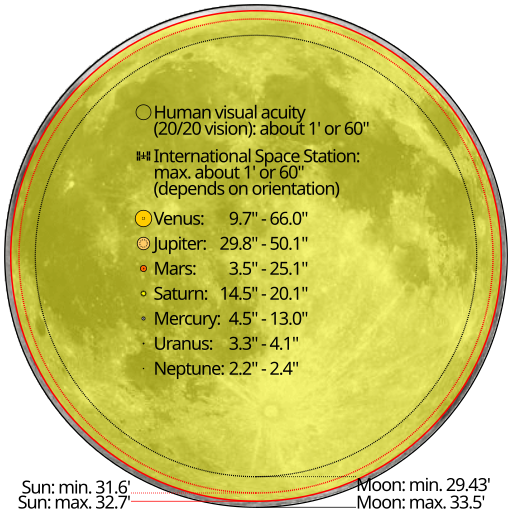File:Comparison angular diameter.svg

Size of this PNG preview of this SVG file: 512 × 512 pixels. Other resolutions: 240 × 240 pixels | 480 × 480 pixels | 600 × 600 pixels | 768 × 768 pixels | 1,024 × 1,024 pixels.
Original file (SVG file, nominally 512 × 512 pixels, file size: 93 KB)
| This is a file from the Wikimedia Commons. The description on its description page there is shown below.
|
Summary
| DescriptionComparison angular diameter.svg |
English: Comparison of angular diameter of the Sun, Moon and planets with the International Space Station and human visual acuity. To get a true representation of the sizes, view the image at a distance of 102.6  times the width of the largest (Moon: max.) circle. For example, if this circle is 10 cm wide on your monitor, view it from 10.26 m away. Planetary angular diameters are from factsheets at http://nssdc.gsfc.nasa.gov/planetary/factsheet/ and Sun/Moon ones are from http://education.gsfc.nasa.gov/eclipse/pages/faq.html times the width of the largest (Moon: max.) circle. For example, if this circle is 10 cm wide on your monitor, view it from 10.26 m away. Planetary angular diameters are from factsheets at http://nssdc.gsfc.nasa.gov/planetary/factsheet/ and Sun/Moon ones are from http://education.gsfc.nasa.gov/eclipse/pages/faq.html |
|||||
| Date | (UTC) | |||||
| Source |
This file was derived from: Full Moon as Seen From Denmark.jpg: The JPG file is used as an embedded raster graphic within this SVG file. |
|||||
| Author |
|
|||||
| SVG development InfoField | This diagram uses embedded text that can be easily translated using a text editor.
|
Licensing
I, the copyright holder of this work, hereby publish it under the following licenses:
This file is licensed under the Creative Commons Attribution-Share Alike 3.0 Unported license.
- You are free:
- to share – to copy, distribute and transmit the work
- to remix – to adapt the work
- Under the following conditions:
- attribution – You must give appropriate credit, provide a link to the license, and indicate if changes were made. You may do so in any reasonable manner, but not in any way that suggests the licensor endorses you or your use.
- share alike – If you remix, transform, or build upon the material, you must distribute your contributions under the same or compatible license as the original.

|
Permission is granted to copy, distribute and/or modify this document under the terms of the GNU Free Documentation License, Version 1.2 or any later version published by the Free Software Foundation; with no Invariant Sections, no Front-Cover Texts, and no Back-Cover Texts. A copy of the license is included in the section entitled GNU Free Documentation License.http://www.gnu.org/copyleft/fdl.htmlGFDLGNU Free Documentation Licensetruetrue |
You may select the license of your choice.
Original upload log
This image is a derivative work of the following images:
- Full Moon as Seen From Denmark.jpg licensed with Cc-by-sa-3.0, GFDL
- 2009-04-07T17:34:33Z Peter Freiman 1000×1000 (772113 Bytes) Bigger size on picture.
- 2009-04-07T16:28:07Z Peter Freiman 805×808 (748395 Bytes) {{Information |Description={{en|1=The full Moon taken from Denmark on 2008-08-18, 00:20. Handhelt shot (Canon EOS 400D, Sigma AF 150-500mm f/5-6.3 DG APO HSM OS, 500 mm, f = 8, 1/400 sec., ISO 400). HDR technique used.}} |Sou
Uploaded with derivativeFX
Captions
Add a one-line explanation of what this file represents
Items portrayed in this file
depicts
23 January 2012
image/svg+xml
8c5b5a689213fc23b032d45355e55853ec2885bd
94,936 byte
512 pixel
512 pixel
File history
Click on a date/time to view the file as it appeared at that time.
| Date/Time | Dimensions | User | Comment | |
|---|---|---|---|---|
| current | 17:16, 27 February 2018 | 512 × 512 (93 KB) | Cantons-de-l'Est | Number layout, again |
File usage
The following page uses this file:
Metadata
This file contains additional information, probably added from the digital camera or scanner used to create or digitize it.
If the file has been modified from its original state, some details may not fully reflect the modified file.
| Short title | Comparison of angular diameter of some celestial bodies |
|---|---|
| Image title | Comparison of angular diameter of the Sun, Moon and planets, compiled by CMG Lee. To get a true representation of the sizes, view the image at a distance of 103 [1 / tan(33.5/60 * pi/180)] times the width of the largest (Moon: max.) circle. For example, if this circle is 10 cm wide on your monitor, view it from 10.3 m away. Planetary angular diameters are from factsheets at http://nssdc.gsfc.nasa.gov/planetary/factsheet/ and Sun/Moon ones are from http://education.gsfc.nasa.gov/eclipse/pages/faq.html . Moon photograph is from http://commons.wikimedia.org/wiki/File:Full_Moon_as_Seen_From_Denmark.jpg . |
| Width | 100% |
| Height | 100% |
